Right. So.
International summer travel in the age of COVID.
Round 2.
I’m technically in the middle of my (after a temporal truncating last year) usual month+ long trip back to Greece, so this isn’t going to be an overall summation / assessment of my summer. Nevertheless, before I get to the core of this post (see title), I figured I’d throw out a couple of general observations.
Call it my usual soapboxing that all of you, I am sure, know and love by now.
I’ll start with the most timely, given the current situation: everyone should get vaccinated. Additionally, more work needs to be done to make vaccines more equitable/accessible to folks in underserved communities (particularly communities of color…and this holds true for France just as it does in the US) as well as more rural areas and/or medical deserts. Insisting on maintaining patents on vaccines/vaccine development technology is ridiculous and will only serve to exacerbate the already deep divide between “wealthy” and “poor” countries. No one should be profiting off this. Period. Furthermore, the global south should not be dependent on “charity” from countries in the global north to kickstart comparatively trickling vaccination programs (though in the short-term, surplus absolutely should be redirected to countries with low vaccine supply…like, yesterday). There are scientists, researchers, laboratories there who are, I am confident, more than capable of fully engaging in the development and manufacturing of current and future COVID-19 vaccines. The greater needs of global public health far outweigh those of generating a profit / maintaining intellectual property rights.
And I also want to acknowledge my own incredible privilege in being able to write this post. I recognize that I am able to travel as I do in part because of my dual US/EU citizenship status, because I get to live in France, and because I had the resources available to me in order to be able to get vaccinated when I was (even though that whole process was its own little hell, given Education Nationale’s insistence that teachers didn’t need to be considered as priority workers).
With that, let’s take a look at Syros.

Syros is a small island in the Cyclades group, as well as the administrative capital of the region. Throughout its history, the island has seen several occupations, but of particular note is that of the Venetians in the 13th century (sometime around the Fourth Crusade). This led to the founding of the town of Ano Syros, located at the top of a hill north-west of the main port, as well as helps explain the decent Catholic population on the island. Following the Greek War of Independence, the early 19th century saw the construction and development of the main port of Ermoupoli, which, up until it was unseated by Piraeus towards the end of the century, was one of, if not the most active commercial ports in the region. The shift to a more tourism-heavy focus in the area only really took off relatively recently (within the last couple decades, give or take). Given this, one of the truly unique things about this island compared to others in the Cyclades – notably Mykonos and Santorini – is that a not-insignificant number of people actually live here year-round and, further, these folks are not necessarily all working in the tourism/tourism-adjacent industry. This is an island, in other words, that is noticeably “lived in”, as the numerous instances of neighbors crossing each other on the streets and stopping to say hello / chat can attest.
In short, if you’re looking for a spot that explicitly caters to tourists, this may not be exactly what you’re looking for. On the other hand, if you want something that is a mix between tourism and local character, you might be in the right place.
[As an aside, I’d also say the same re: a more calm/localized/less explicitly tourism-focused experience when describing Sifnos – which still remains my favorite island in the region – and to a lesser extent Milos, which sees noticeably more tourism traffic than either Sifnos or Syros, but not to the extent that it has become completely overrun. Milos still ranks pretty highly at number 2 for me, if that counts for anything.]
How We Got There
While there is a small airport on the island, the best (and very likely much more affordable) way to get there is by ferry out of Piraeus. The trip is only two hours on the fast ferry (operated by SeaJets – this is the one my parents and I took), but the island is served by most of the major ferry companies (Blue Star Ferries, Hellenic Seaways), so there are definitely other options available (though travel time may vary slightly).
Should you opt for the ferry, you will disembark at Ermoupoli. From there, you can either take the local bus to your destination (though, as with all the islands, while the buses may run pretty much on schedule, they don’t run super frequently, especially when compared to city buses) or catch a cab at the port or in the main square (about a five minute walk). We chose the latter option, after stopping for some coffee and breakfast in a café (the ferry left Piraeus at 07h00 and arrived at 09h00, so we had some time to chill before a 12h00 check-in).
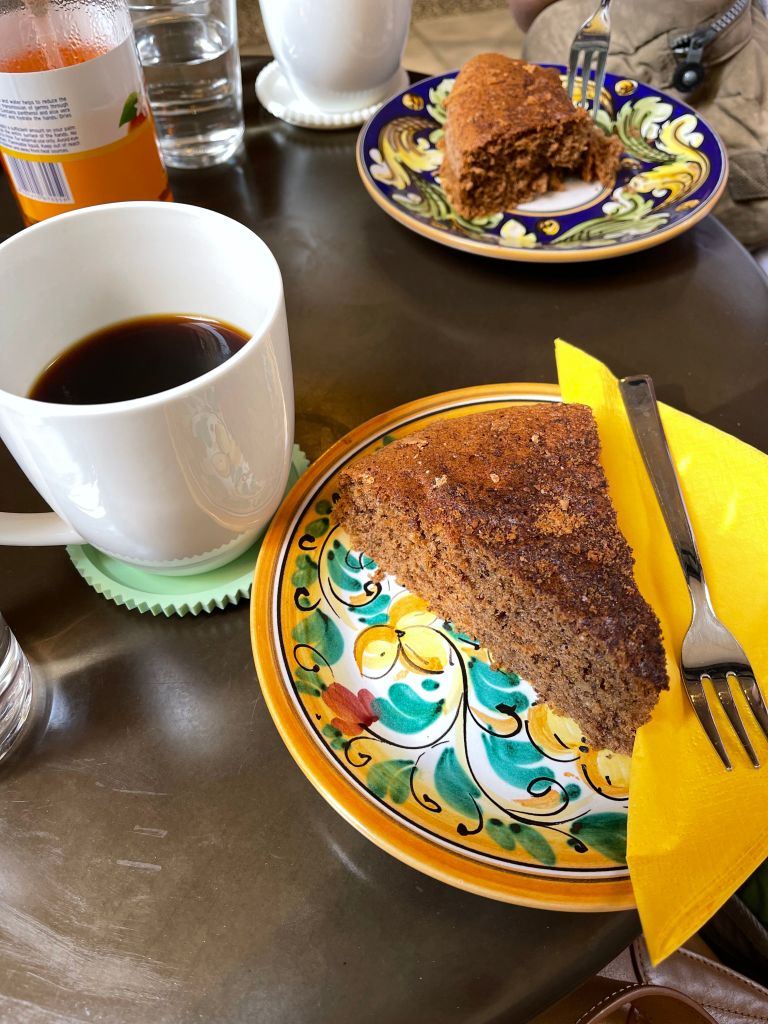
Before moving on to our accommodations / other location specifics, I want to take a second to point out something many folks might not be aware of: Uber isn’t a thing in Greece (which, to be frank, I think is a good thing). As such, you will see taxis everywhere. Many times, on the islands there are set fares to get from one town/village to another (as was the case with Syros), and the cab driver should let you know if there is a set fare / how much it is when you get in (usually you’d tell them first what town/village you’re headed to before the name of your hotel/hostel so they can let you know the price, assuming it’s a standard / set route). Additionally, a cab driver may also give you a business card with their direct number on it. If they do, awesome; getting a ride on an island – especially in cases where the number of cabs on the island is very limited (*cough* Sifnos) – has just gotten a whole lot easier for you.
Plus, your cab driver can be a good source for local info, and who knows, they may even have some…interesting…observations about someone in your group’s celebrity doppelganger (my dad, for example, was deemed, in absolute sincerity, to bear a strong resemblance to JFK. I’ll spare the details, but suffice it to say that my dad looks nothing like JFK).
Where We Stayed
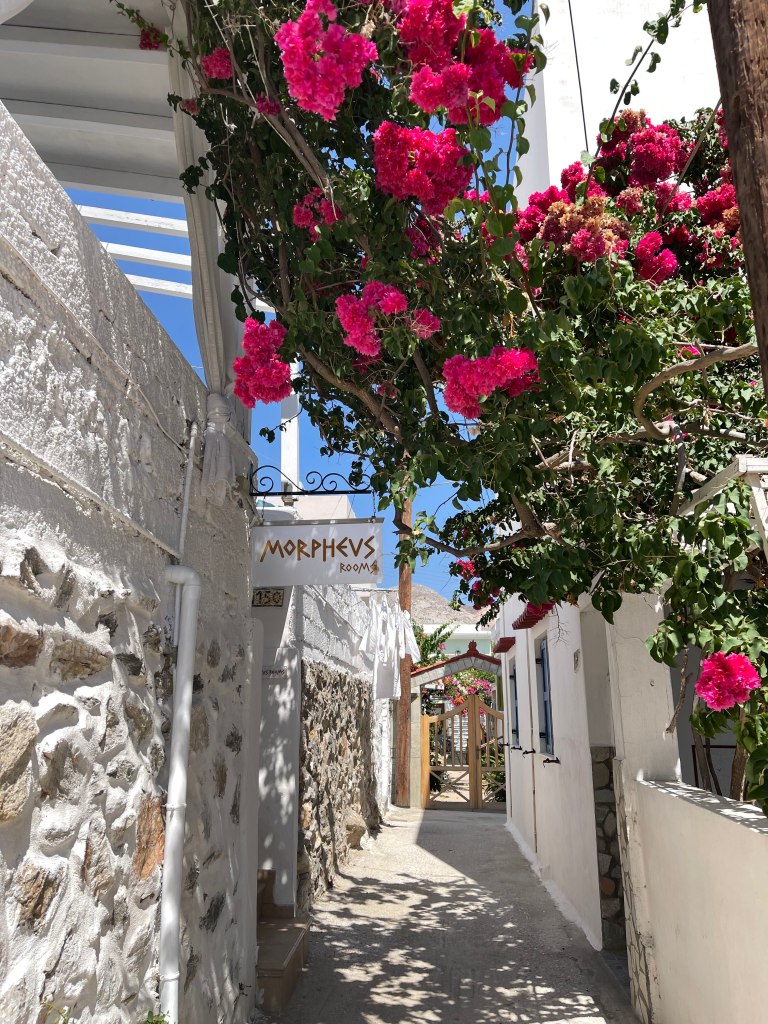
We booked two rooms at Morpheus Rooms in Kini Beach, a small, family-run hotel located in this little beach town on the west side of the island. The drive from Ermoupolis was only about 10 minutes by taxi, and 20 minutes by bus (which I ended up taking a couple of times to do some exploring). We chose the location primarily because of the hotel’s proximity to the beach (literally a minute), but the fact that it’s located on a relatively narrow – and quiet – street definitely worked in its favor, particularly during naptime in the afternoon.
Where We Went and What We Saw There
I’ve decided to break this down by location, rather than go day-by-day to make things a bit easier. For reference, I’ll be starting off with Kini before moving on to Ano Syros and then back to Ermoupolis.
Kini Beach
As mentioned earlier, Kini is pretty much a beach town, so if what you’re looking for is a spot to chill, swim, sunbathe, maybe have some lunch or a drink: you’re in the right place. There is apparently also an aquarium here, though I didn’t really feel the urge to check it out, so can’t really say whether it’s worth a visit or not.

As for beaches, while the many cafés and beach bars along the long, main stretch of Kini Beach provide ample sunbeds / parasols for all-day use for a small price (the café I rented my chair / umbrella from required a minimum 5 euro purchase, so I basically just rounded up the price of the freddo espresso I ordered each morning), on the advice of the daughter of the owner of our hotel, I decided – right after check-in – to make the trek to nearby Lotos Beach. And I say “trek” for a reason. It’s not that the beach is necessarily far (if you were to look to your left while looking out into Kini Bay – which is rather small – it’d be the last small stretch of beach you’d see before a rock outcropping that marks the entrance to open water), it’s just that right before getting there, there’s this hill that’s a bit of a bitch to walk up.
The end result is worth it though. Unlike Kini, this beach is unorganized (save for a few basic, palm frond parasols planted here and there in the sand), so you can plop your towel down wherever there’s an open spot and/or some shade. Like in Kini, the beach here is all sand, and shallow, so you see lots of families with small kids here as well. Just note that, like in many of the Cyclades, the wind can get rather strong sometimes (though not to a really dangerous point), which, while honestly pretty great when it’s super hot out, might mean you should be wary that none of your things start flying about.
We did have dinner at one restaurant in Kini that I’ll post about later. Before moving on, I’d be remiss not to talk about one of the area’s most famous “landmarks”.

Ignore the lighting but behold the Virgin Mary as a mermaid. Apparently, she is the patron saint of those lost at sea. The fountain lights up at night too. This is also where the bus does pick-ups and drop-offs, which is the perfect transition into the next location.
Ano Syros
I had briefly mentioned in the introduction that one thing that distinguishes Syros from other parts of Greece is its small Catholic community. This community was established when the island was under the control of the Venetians, who chose to settle at the top of the hill of what would become Ano Syros, primarily for its strategic location.
Also, yes, for those wondering it is a bit of a hike to get up there from Ermoupolis. Again, though, the effort will be rewarded.

I actually went up to Ano Syros twice. The first time was with the parents on our first night on the island, and we stopped at the (somewhat lower down) Greek Orthodox Cathedral to check out the view before heading back down to Ermoupolis for dinner.


The second time I went was on my own the next afternoon, and this time, I went all the way to the top of the hill.


This is probably the most stereotypically “Cycladic” part of the island, with its winding streets, white buildings and blue roofs / shutters / doorways. The bougainvillea in bloom stood out beautifully against the white, and the quiet from the lack of cars (taxis can only get you to a certain point here) was a welcome contrast from the morning’s bustle in Kini. This part of the island does come back to life around sunset / nighttime, but as I was there just before, my walk was mostly accompanied by the wind and the occasional meowing of one of the many neighborhood cats.

While there’s no real vantage point from which to take a good photo of the outside Saint-George’s Cathedral once you’ve reached it, at least the inside remains open for visitors (and air-conditioned), a little reprieve from the winding hike.

Before moving to the final location, I should also point out that Ano Syros’s other claim to fame (though not sure how much traction this one gets outside of Greece / the Greek diaspora) is that it was the birthplace of Markos Vamvakaris, sometimes called the “patriarch of rebetiko” (a kind of Greek urban popular music, sometimes likened to a sort of Greek “blues”). I’ll link a video of one of his most popular recordings here (a bit cheesy, but this one does include an English translation to follow along with). If you look around carefully, you may even find the lyrics to some of his music painted on the walls around Ano Syros.

Ermoupolis

I spent part of the afternoon of our third day on Syros getting coffee and walking around a bit in Ermoupolis with my mom. Unfortunately, it was too late to check out any of the notable sites (like the theatre, for instance) before they closed for the day, but it was also a touch early to check out any shops, as most hadn’t yet reopened from their afternoon closures / siestas (essential here, as in almost every Mediterranean country), but I did get some nice shots.
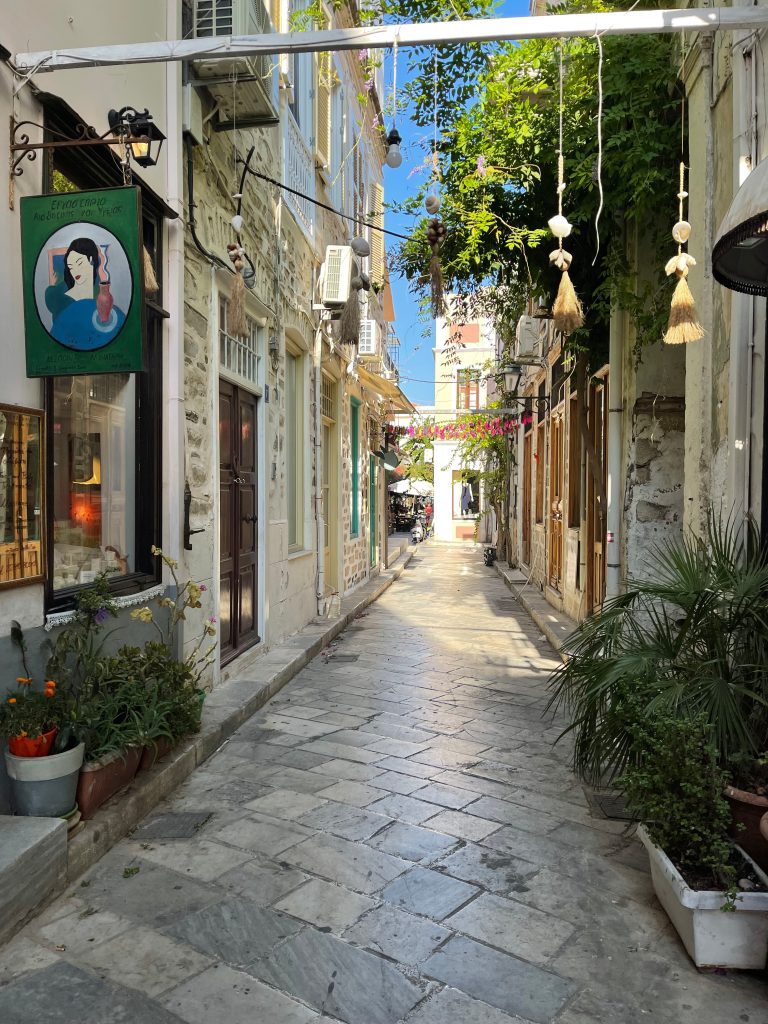
Where (and What) We Ate
Right, now to the moment many of you, I’m sure, have been waiting for. Again, I’m going to separate the descriptions out under headings (and I’ll link to any websites / socials when possible for reference). Note that I’ll be listing restaurants in the order we visited them at.
To Tsipouradiko tis Mirsinis (Ermoupoli)
We weren’t originally planning on eating here on our first night, but when some restaurants we called in Ano Syros while exploring the area told us that they were unfortunately booked up for the evening, I took to my mapstr and found this place, right along the port. While all their outdoor tables were also booked, they did propose us a table just inside (provided we were vaccinated which, we all are). Given how windy it was that evening, dining inside turned out to be a pretty good idea, in the end.
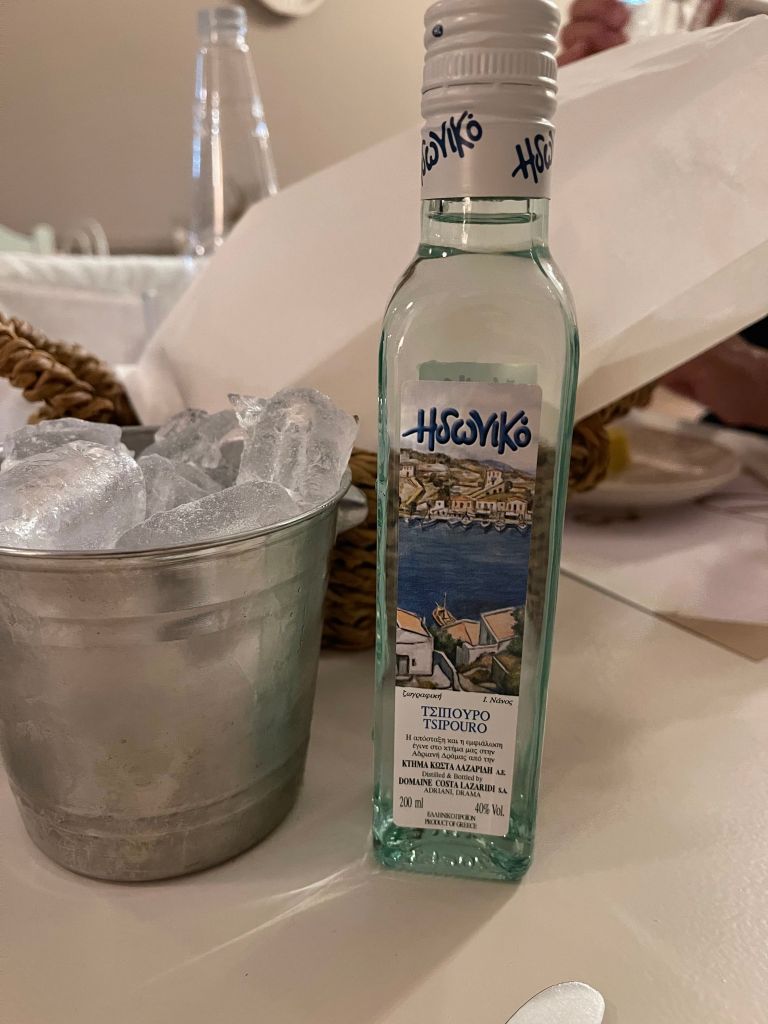
As the name implies, this restaurant is primarily centered on serving tsipouro (a rather strong spirit made from pomace – the residue of the wine press – similar to Italian grappa or Turkish raki) alongside shareable mezze. They have several different kinds of tsipouro on offer, and your waiter will be more than happy to help guide you to one you may like, especially if, like myself/my parents, you’ve had tsipouro before but not enough to develop specific preferences. We opted for a bottle of Idoniko Tsipouro (which, coincidentally, I realized I have a bottle of at home once the waiter brought it out), produced in Drama, in the north of Greece. Note that, while the 200ml bottle may not seem like a lot, this stuff clocks in at around 40% ABV so believe me, you’ll be fine. Like ouzo, tsipouro is commonly served with ice, but unlike ouzo, you don’t add water to your glass to distill the drink down even more.
Unless you’re taking it as a shot (which can be really fun at parties…personally, I’d take a shot of this over vodka any day), tsipouro is meant to be drunk slowly throughout the meal, alongside the several mezze you’ll likely be ordering (and you should plan on ordering a few). As we had not had a full lunch that day, we went basically all out:
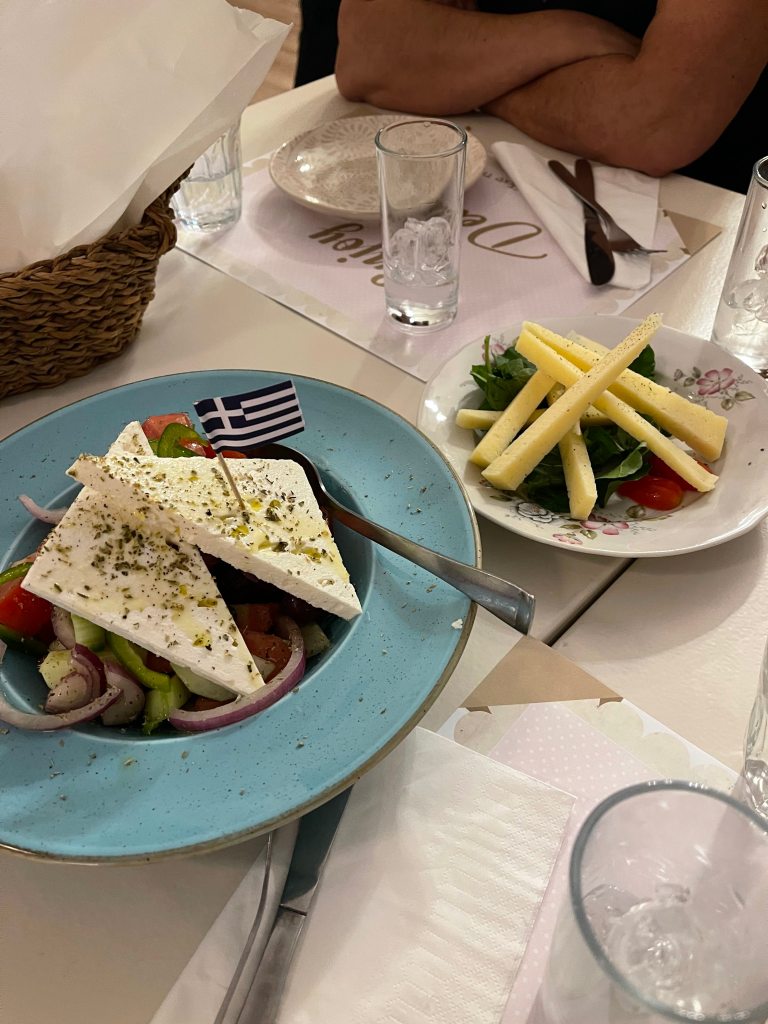
- Greek salad (basically mandatory at this point) and local San Michali cheese

- Marrinated anchovies on toast with tomato and garlic
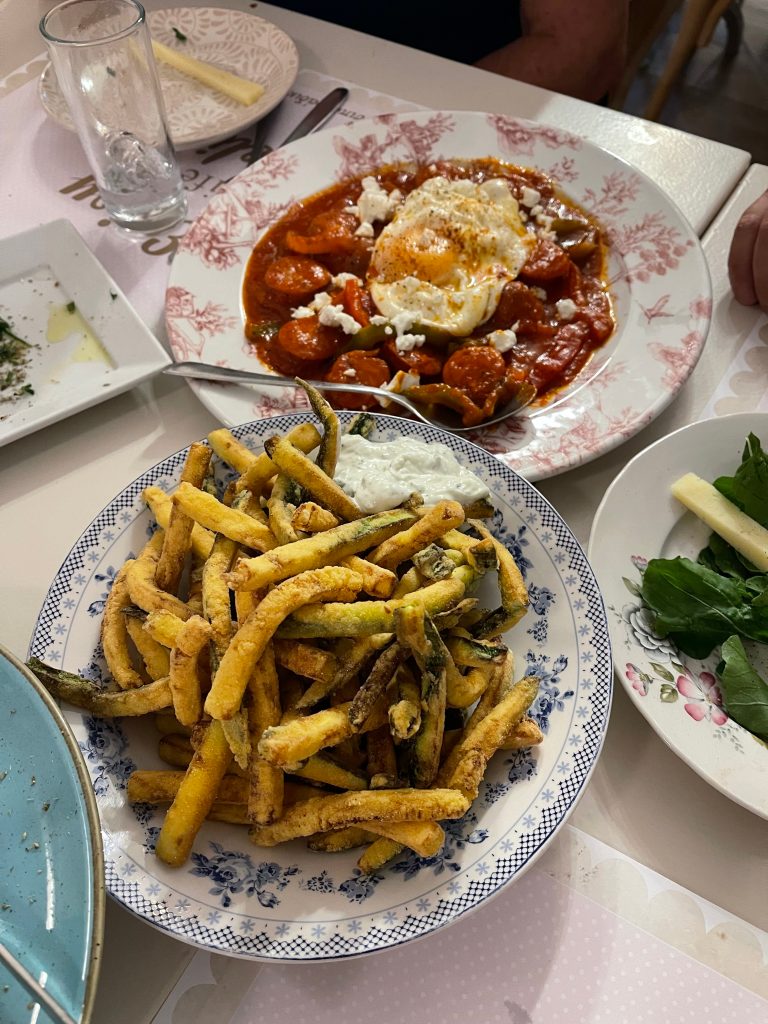
- Fried zucchini (I had never seen it served this way before – usually zucchini is fried in disks – but I want to go on the record and say this is genius) with tzatziki and loukaniko sausage in tomato sauce with a fried egg (guess who did not eat the egg? Yeah, me.)

- Oven-cooked lamb with fennel and potatoes, topped with shaved San Michali cheese. The lamb was just melt-in-your-mouth good. Very glad I saved room for it.
To say that we were stuffed at the end is a bit of an understatement (though I did welcome the complimentary shot of masticha liqueur at the end of the meal as a digestif), but nevertheless, we did manage to roll our way into a cab and back to the hotel to rest up for the next day of more eating.
By the way, some of you who have read my other travel recaps before may be noticing that there are comparatively fewer restaurants on the list this time around. This has nothing to do with any lack of good food in Syros, but more with the fact that other than dinner (and one lunch before jumping on the ferry back to Piraeus), other meals tended to be more independent. No, instead, we saved our appetites for dinner. While we did not partake in quite the same level of intense feasting on our second evening as we did during our first, I would still say we ate quite well.
Allou Yialou is arguably one of the best seafood restaurants on the island, though I will also relativize this slightly by saying that contrary to what one may believe, given its geography/location, Syros is not really a big fish-consuming island. The exception here is Kini, where you can still find fishing boats anchored along the right side of the bay. Conveniently, this restaurant was also located only steps away from our hotel – and they also took online bookings – making it the perfect choice for a post-sunset dinner.
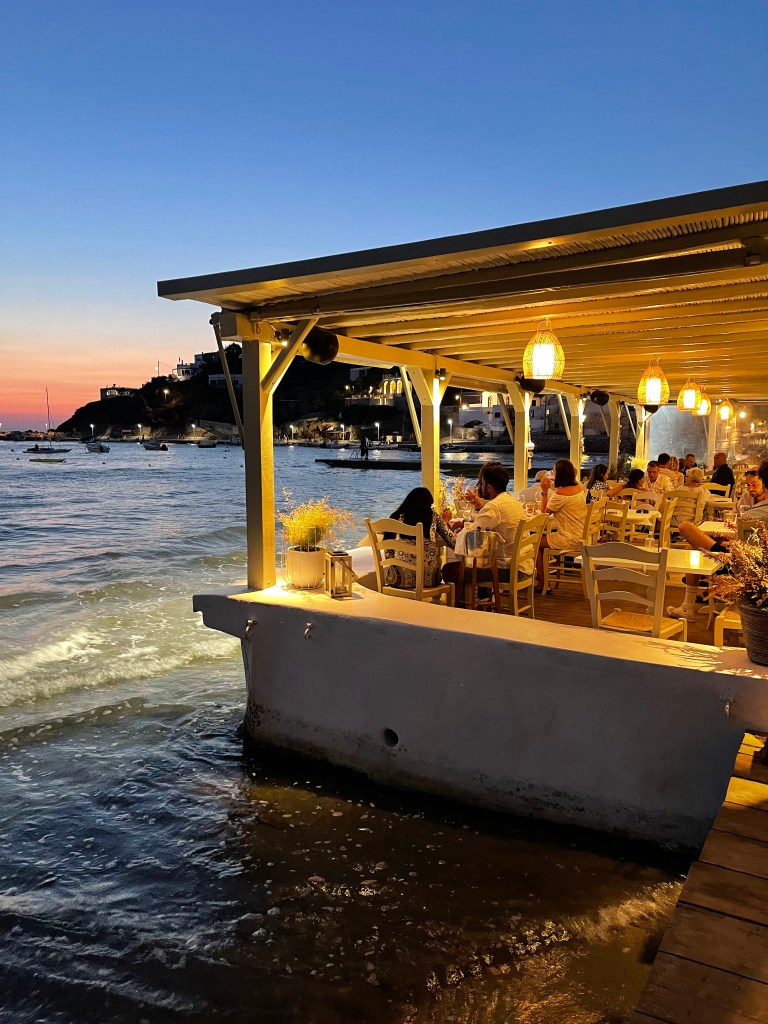
That there is not much other competition in the seafood department does not mean that Allou Yialou is not objectively good, however. It is good. Quite good. And, should you want to opt for a whole grilled fish as we did, a nice surprise is finding that the prices by the kilo aren’t that much different from what you can find on the mainland either.
The restaurant’s other claim to fame in the fish/seafood department is revisiting classic Greek dishes with a slight twist, using local ingredients. I did not try any of these dishes – as the fam and I opted for the whole grilled fish option as we almost always do when going out for fish in Greece – but judging by how other tables reacted to their meals, I’d say you can be happy with whatever choice you make here.
For our part, however, in the aim of keeping things a bit lighter than the night before, we started off with some revithada (which, yes, is a dish local to Sifnos, not Syros, but whatever):

Followed by the aforementioned fish (in our case, a whole grilled Porgy), which was presented and then butterflied/deboned tableside:

I mean, maybe I am just unoriginal at this point, but you really can’t go wrong with a whole fish like this.
To close out the meal, we were also treated to complimentary slices of portokalopita (orange cake). And yes, in case this has not become clear, offering a complimentary dessert or fruit post-meal is a thing in Greece (though not every establishment automatically does it).

For our final dinner, we opted to follow the recommendation of our cab driver and check out Mitsos, a traditional taverna, and one of the few restaurants on the island that’s open even during the winter / off-season. The spot is pretty loved by local residents, and that plus its increased popularity with visitors means that one would do well to call ahead to book a table (as we did).

We were hoping to get to try some of the μαγειρευτά (“megeireuta” or slow-cooked) dishes the restaurant was known for, but as they had unfortunately run out of portions at lunchtime (not necessarily a bad thing in terms of freshness / reasonable food quantities) we opted for some mezze and grilled meats instead.
We started with some green beans, skordalia (garlic dip – for those who really, REALLY like garlic, which I do), beets and beet greens, and fried San Michali cheese:

Followed by grilled lamb chops (which were excellent) and seftelia, Cypriot lamb meatballs wrapped in lamb caul and grilled:

And I honestly cannot remember if we even touched what they brought out as a little sweet…that’s how full we were after this meal.
Taverna To Petrino (Ermoupoli)
Finally, I don’t have any photos from the spot where we had lunch before taking the ferry, but I do want to take a minute to highlight the place anyway. First off, the outdoor seating here is lovely. Located down a small street – and sandwiched between some other taverna’s / cafés – and covered in a canopy of bougainvillea, it provides a welcome respite from the sun, and a bit of calm away from the bustle of the nearby port. We kept it vegetarian here (which is incredibly easy to do in Greece, by the way) and along with the ubiquitous Greek salad, ordered two other dishes that I highly recommend, should any of you ever find yourselves here:
- Marathopita: spinach and fennel pie
- Eggplant pilaf: it sounds incredibly basic but honestly with eggplant that creamy and a warming hit of cinnamon, this became an easy favorite.
Café Mentions: Café Bistro Feggari (Ano Syros) and Ellinikon Kafeneion (Ermoupoli)
Finally, to close out all things restos, a special shout-out to a couple of café’s I visited for refreshment and (in the case of the second) decadence.
First, Café Bistro Feggari in Ano Syros where I treated myself to a nice cold lemonade on their rooftop patio after hiking up all those stairs and around the neighborhood.

Second, Ellinikon Kafeneion in Ermoupoli – right across from the main square – where my mom and I treated ourselves to coffee and quite possibly the most generous single-serving of karidopita (walnut cake) I have ever seen in my life.
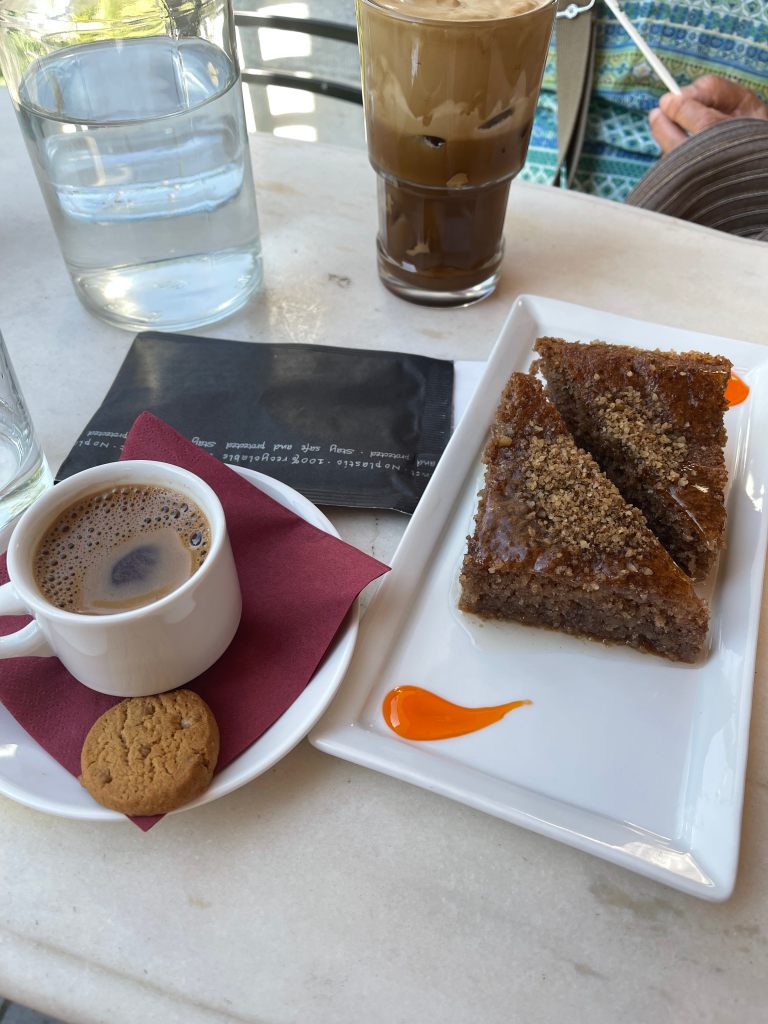
Local specialties
As to local gastronomic specialties (other than the San Michali cheese, which made a few appearances during our meal) arguably the island’s biggest claim to food fame is its loukoumi or Turkish delight. Of course, this is not to say they invented them. Rather, that the island has an established reputation for making particularly good ones. You’ll find several shops selling them along with the Syros’s other sweet specialty, halvathopita (basically, imagine nougat sandwiched between two very giant communion wafers), near the port and elsewhere on the island.
Overall
As I mentioned earlier (albeit parenthetically), Sifnos still has my heart as my favorite island of the Cyclades (if not favorite island I’ve visited in Greece, period). With that being said, I really enjoyed my time in Syros, and could maybe even have done with another day either to do some hiking or possibly explore another beach. Ah well. Perhaps another time.
Until then – and until I come back again full-force at the rentrée with all my opinions regarding all things theatre – I hope those who’ve stuck through to the end of this recap have found it informative or, at the very least, enjoyable.
In any case, this has rambled on long enough and I’ve got another beach to get to.



Loved reading this! I’ve always wanted to go to Greece and it sounds lovely!
LikeLiked by 1 person